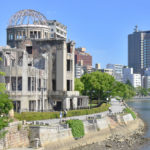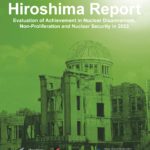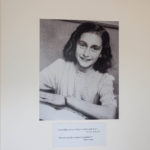4 The Establishment of New Education and Promotion of Empirical Learning
Coinciding with the start of the new semester in April, 1947, new elementary schools and junior high schools under a new education system (the “three-six-year,” or compulsory nine-year education system) commenced 48). At the same time, Honkawa National School changed its name to Honkawa Elementary School. Ahead of the new system’s launch, preparation for education reconstruction had been made a year before. For instance, “A Guide for the New Education” 49)was issued by the Ministry of Education on May 15th, 1946, explaining that “the weakness of the Japanese people is their low scientific level and lack of rational spirit” and that because of this “it is easy for militarists and extreme nationalist to take advantage of these weak points” 50). “A love of truth, that is, the ability to pursue the truth, to tell the truth, and to carry out the truth, is necessary to avoid being misled by leaders” 51). After that, the Constitution of Japan was established on November 3rd, with the Fundamental Law of Education and School Education Act announced on March 31st of the following year. In parallel with these, the Course of Study (draft) was presented on March 20th.
In keeping with these nationwide shifts, entrance ceremonies and opening ceremonies for the new semester were conducted on April 7th, 1947 in Hiroshima. However, after that, preparation for the transition to a new education system lagged, and schools in Hiroshima City ended up starting classes from April 15th. This new education system started after the end of the war is influenced by American child-centered education52). One typical example is the Koi Plan, which promoted the introduction of the new education system in Hiroshima. The plan involved three meetings conducted between autumn 1946 and 1949, and aimed to develop “modern Japanese people (who have scientific minds, individual initiative and social ability)” and proposed an ideal model as “children who are sound both physically and mentally (thinking, strong and cheerful)” 53). The plan also included a curriculum which consisted of four “experience” areas54): 1) Social life (a course designed for solving problems associated with nature, society and humanity, intended to improve practical problems), 2) Enriching lives (aesthetic education such as the arts, music and literature), 3) the Body (aspects of health such as physical education and sanitation) and 4) basic skills required for learning (language, mathematics and measurement and home-economics-related skills). Based on these areas, a more specific curriculum was established and named the “Life Program” including Shigoto (lit. “work”; experiential learning), Osarae (lit. “reviewing”; repetition drills of basics) and Migaki (lit. “polishing up”; systematic learning). Shigoto was an experiential learning course “designed for the creation, sustenance and development of life and society. By covering meaningful lives associated with the aspiration of peace, this intends to make children practical citizens.” With regard to the knowledge and skills that could not be obtained through experiential learning, the systematic learning course Migaki made up for them. The repetition drills required for Oshie in the lower grades were integrated into Migaki 55).
This new education of experience was also found in Honkawa Elementary School after 1947. At the school, the curriculum evolved with school events at the core. For example, a school-wide circus observation on May 22nd was followed by home visits by teachers starting from June 2nd and lasting for a week 56). Home visits were a school event that built relations between teachers and parents through school teachers’ visiting students’ homes and reporting children’s grades and their school life. In addition to these events, a traffic safety guidance by the occupying forces was held on June 9th, and mothers’ classes 57)took place on the 16th. Mothers’ classes were childcare workshops intended for mothers. Such family-related workshops and meetings were also held at the school. On August 5th, a Performing Presentation and Exhibition was held at the school in the days prior to the anniversary of the atomic bombing. A Honkawa School District Memorial Service was conducted on the 6th followed by a School Reunion on the 7th. In addition, the first sports festival after the end of the war was held on October 15th58). In December, the emperor visited Hiroshima. On New Year’s Day, 1948, Haigashiki (lit. “celebration of the new year”) and the School Reconstruction Ceremony took place, followed by the Anniversary of the School and Exhibition of Memorial Works on the 10th and Investiture Ceremony of Student Council Members on the 13th59). After that, numerous school events took place one after another, such as picnics, evacuation drills, school plays, a joint-sport festival, seaside schooling, school painting and calligraphy contests, and swimming lessons in the Honkawa River. As such, the school was reconstructed in the midst of events that involved the local community. In addition, the experiential learning opportunities had expanded outside of the school and into the local community. Examples were the Bunka Kokka Kensetsu Gakusei Taikai (lit. “Students’ Conference on Construction of a Cultural Country”) held on February 2nd, in which Honkawa Elementary School students in the 5th grade and higher took part, and 6th graders’ school excursion to Itsukushima Shrine on March 20th. Furthermore, following the formation of the Honkawa Elementary School Red Cross on June 28th, children started to participate in social activities including Heiwasai Hanakoushin (lit. “Peace Flower Parade”) and the opening ceremony of Yokogawa Bridge 60).
Additionally, the supporting system managed by parents and the local community was getting on the right track. A preparatory meeting for the establishment of the Honkawa Elementary School Parent-Teacher Association was held by community parents on March 24th, 1948. Eventually, the association played a central role in collecting petition signatures appealing for the construction of a new school building61). Also, a substantial amount of support from overseas was gathered, including letters and books from an elementary school in Austin, Minnesota and donations from the American Red Cross Youth62). On May 2nd , when Dr. Howard Bell revisited Hiroshima, the institute and the local community organized a big welcome party 63).
48)In addition to elementary schools and junior high schools, kindergartens were also established.(Hiroshima City Board of Education (1981), p.161)
49)A Guide for the “New Education” by the Education Ministry was issued in parts: the first part was published on May 15th, 1946, the second part was published on June 30th , and the third part was published in November 15th, in the same year. The fourth part was published on February 15th, 1947.
50)Ministry of Education, “Shinkyouiku Shishin: Dai Ichibu Zenpan” (Guide for the New Education: Section 1, Part 1), 1946, Sengo Kyouiku Kaikaku Koso I ki 2: Shinkyouiku Shishin (Fu, Eibun) (Phase I of the Plan to Reform Postwar Education 2: New Education Guidelines [English language version included], Nihon Tosho Center, 2000, p.29
51)Ibid., p.29
52)Mizuhara Katsutoshi, “Gendai Nihon no Kyouiku Katei no Ayumi” (Curriculum Development in Modern Japan), In Koji Tanaka; Katsutoshi Mizuhara, Hatsuo Mitsuishi; and Kanae Nishioka, Atarashii Jidai no Kyouiku Katei, Kaiteiban (Curriculum in a New Period), Yuhikaku, 2nd Ed., 2009: p.46
53)“Gakudosokai deno Seikatsu no Jittai”(Reality of Evacuation of Schoolchildren), Senchu Sengo ni Okeru Hiroshimashi no Kokumin Gakko Kyouiku” (National School Education in Hiroshima during and after the War)p.222
54)Ibid., p.222
55)Ibid., pp.222-223
56)Honkawa Elementary School (1948)
57)Honkawa Elementary School (1973), “Koushihen”(School History), In Souritsu Hyakushunen Kinenshi (Memorial Magazine of 100th Anniversary of Establishment), Hiroshima Elementary School Executive Committee of 100th Anniversary of Establishment, p.60
58)Ibid.,p.60
59)Honkawa Elementary School (1948)
60)Honkawa Elementary School (1973), p.61
61)Ibid.,p.62
62)Ibid.,pp.60-61
63)Toshikuni Nakagawa(2015), pp.11-12








